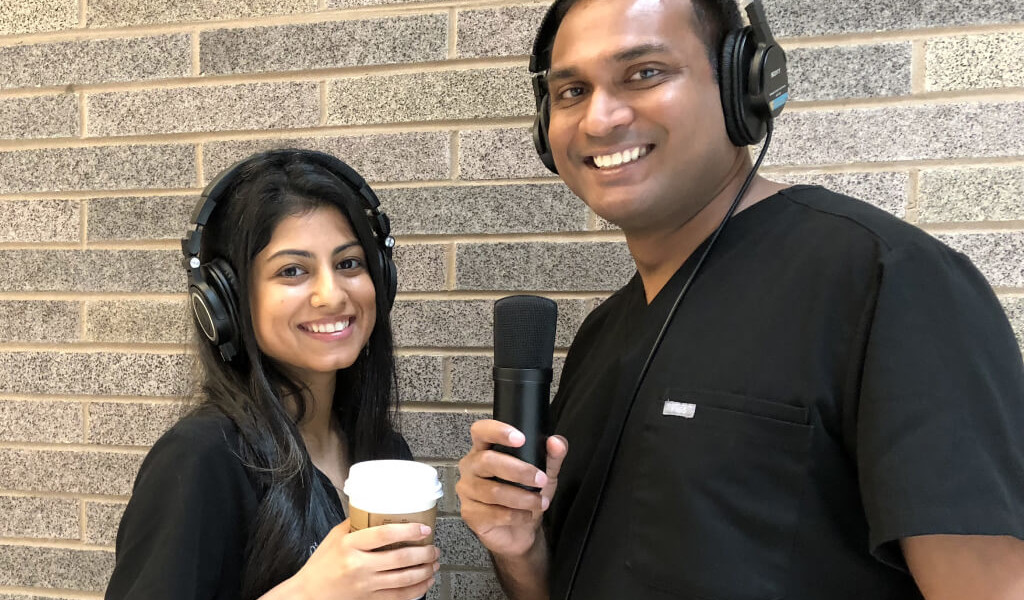Podcast Ep 46: Lung Abscesses, Head Injuries, Anaphylaxis & More

Only those who dare to fail greatly can ever achieve greatly.
–Robert F. Kennedy
Welcome back to RoshCast for Episode 46! Let’s kick off this episode with a rapid review of molluscum contagiosum.

- Molloscum contagiosum is caused by poxvirus. It is seen in children, sexually active adults, and immunocompromised patients like those with HIV.
- The rash presents as painless, pearly, umbilicate papules, and it is spread by direct skin-to-skin contact.
- Children present with lesions on the face, trunk, and extremities, whereas sexually active adults can present with lesions in the genital regions, lower abdomen, and thighs. The rash tends to spare the palms and soles.
- Most patient will not require therapy with spontaneous resolution occurring in months. Those with extensive lesions may benefit from cryotherapy.
- HIV positive patients with a CD4 count less than 100 are at greater risk for developing molluscum contagiosum.
Now onto this week’s podcast
Question 1
Which of the following organisms is one of the most commonly implicated in the development of a lung abscess?
A. Klebsiella pneumoniae
B. Peptostreptococcus
C. Staphylococcus aureus
D. Streptococcus pneumoniae
Question 2
A 26-year-old man presents to the ED after being hit in the head by a foul baseball. The patient was initially alert and talking to you. He is now becoming progressively more somnolent. Which of the following would you expect to see on a non-contrast computed tomography scan of the head?
A. A collection of blood layering in the basilar cisterns
B. A crescent-shaped frontal hematoma crossing suture lines
C. A lenticular-shaped hematoma in the temporal region
D. An intraparenchymal hemorrhage within the frontal lobe
Question 3
A 55-year-old man who is taking several antihypertensive medications presents to the ED with nausea, vomiting, shortness of breath, and a rash after eating a home-cooked Thai meal at a friend’s house about one hour ago. The symptoms began within seconds of the first bite of his meal. Despite the patient being administered 2 doses of intramuscular epinephrine, diphenhydramine, dexamethasone, and crystalloid fluids, his blood pressure remains at 75/38 mm Hg. Which other medication should be considered in this patient?
A. Cimetidine
B. Glucagon
C. Norepinephrine
D. Octreotide
Question 4
A 36-year-old man presents to the ED after having a seizure. He has a folder full of medical records dating back 15 years. Several of the records are from other cities and states. It is now 11:00 pm on a Friday night. His primary care physician, neurologist, and psychiatrist are “out of town,” and he believes that he needs to be admitted for the duration of the weekend. He has another episode in the ED and immediately following this he returns to his baseline. He is now awake and alert. You immediately draw a serum lactate and it is normal. Which of the following diagnoses should be strongly considered in this patient?
A. Conversion disorder
B. Hypochondriasis
C. Munchausen syndrome
D. Somatization
Question 5
A 4-year-old boy is brought to the emergency department by his parents after they found him in the backyard shed choking and gagging. Before this event, he was otherwise healthy. His temperature is 101°F, heart rate is 95 bpm, blood pressure is 100/60 mm Hg, and respiratory rate 40/min. On exam, he appears sleepy but continues to cough. Pulmonary findings include moderate retractions and diffuse wheezes. A chest X-ray shows patchy infiltrates. What is the most likely diagnosis?
A. Foreign body aspiration
B. Hydrocarbon ingestion
C. Organophosphate ingestion
D. Status asthmaticus
Question 6
A 12-year-old boy presents to the ED after his brother bumped into his elbow while he was using a cotton-tipped swab to clean out his ear. He denies dizziness, vertigo, nausea, or hearing loss. On exam, you note a tear of the tympanic membrane and a small amount of blood in the external canal. Which of the following is the most appropriate next step in management?
A. Begin antibiotics
B. Discharge with instructions to keep the ear canal dry
C. Emergency department consultation to ENT
D. Pack the ear with gauze

- Anaerobes like Prevotella, Bacteroides, Fusobacterium, and Peptostreptococcus are the most common organisms found in a lung abscess.
- On chest radiograph, lung abscesses present as a consolidation with an air fluid level inside a cavitary lesion.
- An epidural hematoma presents as a hyperdense lenticular-shaped hematoma in the temporal region, and it is caused by a tear in the middle meningeal artery. A lucid interval is often associated with this bleed.
- Patients taking beta-blockers for hypertension may exhibit persistent hypotension in the setting of anaphylactic shock. They should be treated with glucagon to free up the beta receptor and potentiate the circulating epinephrine to restore vasomotor tone.
- In Munchausen syndrome, the individual feigns disease in an attempt to gain attention, sympathy, or reassurance.
- Somatization disorder is characterized by unexplained physical symptoms that lead to significant social and occupational impairment.
- Conversion disorder is characterized by an unexplained neurologic symptom triggered by a psychological stressor.
- Hydrocarbon ingestion can cause pneumonitis, and the chest X-ray can show diffuse bilateral infiltrates.
- Patients with asymptomatic ruptured tympanic membranes can be discharged home with instructions to keep the canal dry. Symptomatic patients require emergent ENT consultation.
That wraps up RoshCast Episode 46! Be sure to also check out the rest of the Rosh Review Blog for questions from prior episodes, related images and tables, and bonus teaching points. There are also tons of other great free resources to help prepare you for the boards and the wards. Don’t forget to follow us on twitter @RoshCast. And you can always email us at RoshCast@RoshReview.com with any feedback, corrections, or suggestions.
You can also help us pick questions by identifying ones you would like us to review. Write “RoshCast” in the Submit Feedback box as you go through the question bank. Lastly, if you have a minute, make sure to rate us and leave comments on iTunes to help spread the word about RoshCast.
Megha and Nachi





Comments (0)